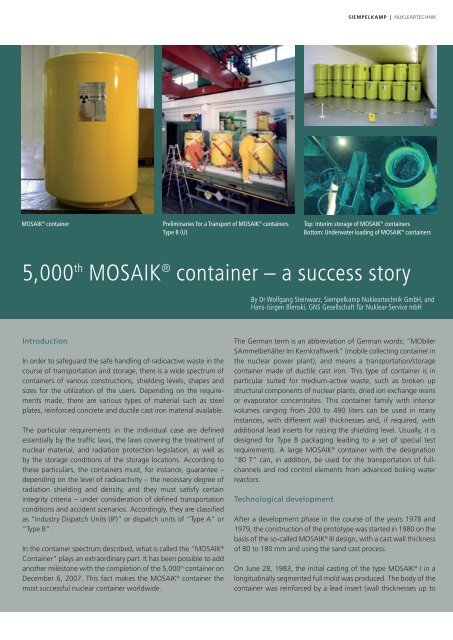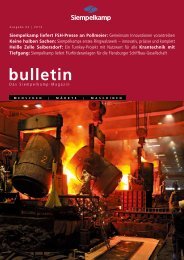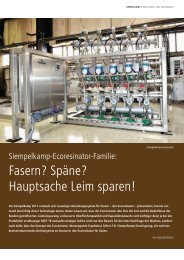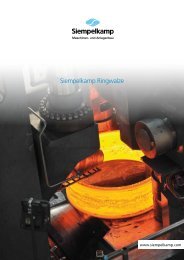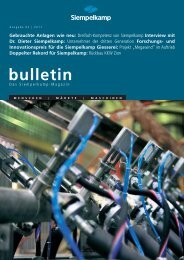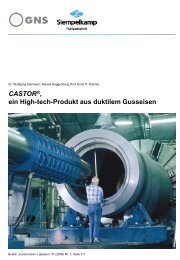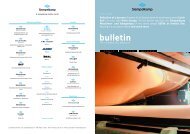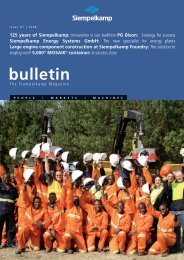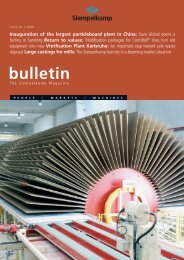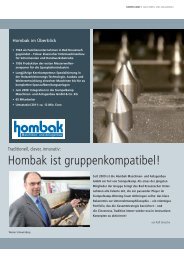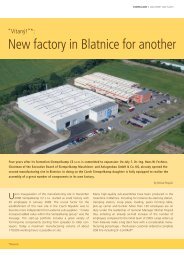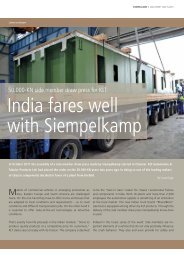5,000th MOSAIK® container – a success story - Siempelkamp
5,000th MOSAIK® container – a success story - Siempelkamp
5,000th MOSAIK® container – a success story - Siempelkamp
Create successful ePaper yourself
Turn your PDF publications into a flip-book with our unique Google optimized e-Paper software.
MOSAIK ® <strong>container</strong> Preliminaries for a Transport of MOSAIK ® <strong>container</strong>s<br />
Type B (U)<br />
Introduction<br />
In order to safeguard the safe handling of radioactive waste in the<br />
course of transportation and storage, there is a wide spectrum of<br />
<strong>container</strong>s of various constructions, shielding levels, shapes and<br />
sizes for the utilization of the users. Depending on the requirements<br />
made, there are various types of material such as steel<br />
plates, reinforced concrete and ductile cast iron material available.<br />
The particular requirements in the individual case are defined<br />
essentially by the traffic laws, the laws covering the treatment of<br />
nuclear material, and radiation protection legislation, as well as<br />
by the storage conditions of the storage locations. According to<br />
these particulars, the <strong>container</strong>s must, for instance, guarantee <strong>–</strong><br />
depending on the level of radioactivity <strong>–</strong> the necessary degree of<br />
radiation shielding and density, and they must satisfy certain<br />
integrity criteria <strong>–</strong> under consideration of defined transportation<br />
conditions and accident scenarios. Accordingly, they are classified<br />
as “Industry Dispatch Units (IP)” or dispatch units of “Type A” or<br />
“Type B”.<br />
In the <strong>container</strong> spectrum described, what is called the “MOSAIK ®<br />
Container” plays an extraordinary part. It has been possible to add<br />
another milestone with the completion of the 5,000 th <strong>container</strong> on<br />
December 6, 2007. This fact makes the MOSAIK ® <strong>container</strong> the<br />
most <strong>success</strong>ful nuclear <strong>container</strong> worldwide.<br />
SIEMPELKAMP | NUKLEARTECHNIK<br />
The German term is an abbreviation of German words: “MObiler<br />
SAmmelbehälter Im Kernkraftwerk” (mobile collecting <strong>container</strong> in<br />
the nuclear power plant), and means a transportation/storage<br />
<strong>container</strong> made of ductile cast iron. This type of <strong>container</strong> is in<br />
particular suited for medium-active waste, such as broken up<br />
structural components of nuclear plants, dried ion exchange resins<br />
or evaporator concentrates. This <strong>container</strong> family with interior<br />
volumes ranging from 200 to 490 liters can be used in many<br />
instances, with different wall thicknesses and, if required, with<br />
additional lead inserts for raising the shielding level. Usually, it is<br />
designed for Type B packaging leading to a set of special test<br />
requirements. A large MOSAIK ® <strong>container</strong> with the designation<br />
“80 T” can, in addition, be used for the transportation of fullchannels<br />
and rod control elements from advanced boiling water<br />
reactors.<br />
Technological development<br />
Top: Interim storage of MOSAIK ® <strong>container</strong>s<br />
Bottom: Underwater loading of MOSAIK ® <strong>container</strong>s<br />
5,000 th MOSAIK ® <strong>container</strong> <strong>–</strong> a <strong>success</strong> <strong>story</strong><br />
By Dr Wolfgang Steinwarz, <strong>Siempelkamp</strong> Nukleartechnik GmbH, and<br />
Hans-Jürgen Blenski, GNS Gesellschaft für Nuklear-Service mbH<br />
After a development phase in the course of the years 1978 and<br />
1979, the construction of the prototype was started in 1980 on the<br />
basis of the so-called MOSAIK ® III design, with a cast wall thickness<br />
of 80 to 180 mm and using the sand cast process.<br />
On June 28, 1983, the initial casting of the type MOSAIK ® I in a<br />
longitudinally segmented full mold was produced. The body of the<br />
<strong>container</strong> was reinforced by a lead insert (wall thicknesses up to
SIEMPELKAMP | NUKLEARTECHNIK 46 | 47<br />
90 mm) cast into the ductile cast iron shell, while a sand core was<br />
utilized.<br />
The first type B acceptance of a MOSAIK ® of the II-15 U type was<br />
carried out in 1991.<br />
Our MOSAIK ® production began in 1980 with a run of ten <strong>container</strong>s;<br />
it reached its current maximum in 1993 with 483 <strong>container</strong>s<br />
and settled in 2007 and for the planned following years at<br />
approximately 250-300 units per year.<br />
As a matter of course, some details in the field of casting technology<br />
have been changed over the course of the years; some<br />
minor changes have been introduced as regards composition and<br />
characteristic technical features of the cast iron material to achieve<br />
the current specifications for today’s ductile cast iron of the type<br />
GJS-400-15C. Last but not least, the coating quality has been<br />
greatly improved.<br />
The cast product remains, of course, as the central event of production.<br />
Thus within a very short time all prerequisites are delivered<br />
for the final quality product.<br />
As a further highlight of the manufacturing process, the use of<br />
recycling material is to be mentioned. Since 1989, the so-called<br />
decontamination melting process has been used at the CARLA<br />
Plant in Krefeld for the treatment and utilization of weakly radioactive<br />
metallic residual materials.<br />
In the course of this process, a reduction of the waste material<br />
down to approximately 5% of the starting volume and a lowering<br />
of the contamination degree is achieved. The material reprocessed<br />
in this way is used again in particular in the form of ingots for the<br />
production of MOSAIK ® <strong>container</strong>s, which is of great advantage in<br />
the process efficiency both for the customer and the manufacturer.<br />
The proportion of the recycled material depends on the quality of<br />
the starting material and the requirements the <strong>container</strong>s have to<br />
meet. Usually, the proportions range in the case of the MOSAIK ®<br />
<strong>container</strong>s at about 25%, which value in the course of the years<br />
will result in a recycling mass containing a total of more than 5,000 Mg.<br />
MOSAIK ® casting arrangement Top: “CARLA” <strong>–</strong> Recycling of low active<br />
metallic waste<br />
Bottom: Microstructure of the ductile cast<br />
iron material with embedded graphite<br />
elements<br />
This recycling path ideally combines economical utilization of the<br />
resources with a residual activity remaining in the nuclear circulation,<br />
and it thus contributes to the reduction of the volume in the<br />
final storage and of the costs involved.<br />
Basic properties of the materials and Quality Assurance<br />
The MOSAIK ® <strong>container</strong> is a type of <strong>container</strong> which has to meet<br />
the requirements resulting from the transportation and storage<br />
conditions. This fact entails in particular special characteristic<br />
features in terms of quality for the material, and these characteristics<br />
are completely met by cast iron with spherical graphite of the type<br />
GJS-400-15C according to DIN EN 1563. The ferrite microstructure<br />
with built-in spherically formed graphite elements ensures a<br />
corresponding behavior of the <strong>container</strong> material. Responsible<br />
for this fact are in particular the content of carbon, which at<br />
approximately 3.6% is relatively high, and a chemical analysis<br />
refined in detail, with particular trace elements. An essential advantage<br />
is the monolithic structure of the <strong>container</strong> body, which<br />
effectively under the motto “everything made of one cast” fulfills<br />
the requirements of safe enclosure and the shielding without any<br />
additional seams.<br />
The suitability of the material is proven in the framework of experimental<br />
test series and safety analyses.<br />
The mechanical characteristic values of the material to be guaranteed<br />
are determined by samples obtained by means of the hollow<br />
drilling technique which have been taken from the centre of the<br />
cylinder wall.<br />
A detailed program with ultrasonic testing, overload and tightness<br />
testing and other additional measures, as well as a far-reaching<br />
manufacturing qualification, ensure comprehensive quality assurance.<br />
On the basis of these particulars, it has been possible to establish<br />
the MOSAIK ® <strong>container</strong> as one of the central instruments of a safe<br />
and secure disposal process.<br />
800 m drop test of MOSAIK ® <strong>container</strong> (1983)


